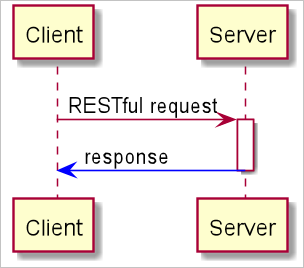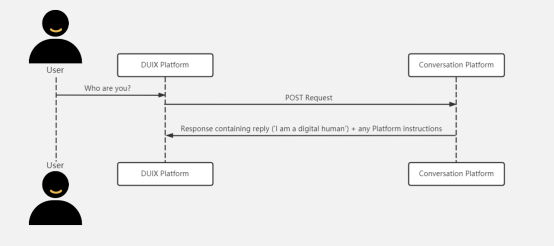
# OpenAPI Integration
# Prerequisites
# Generate Signature to Get Token
When integrating with the duix-openapi-v2 platform, you need to integrate token generation code in your platform. You can refer to the following code for generating tokens:
# Verify Token
API Endpoint:
/duix-openapi-v2/sdk/checkSig
Request Method: GET
Request Data Type: application/json
Response Data Type: application/json
# Description:
Verify token validity and return the WebSocket connection address for real-time digital human interaction
# Parameters
| Parameter Name | Type | Pass Method | Description |
|---|---|---|---|
| sig | String | Query | Same as token |
# Response Parameters:
| Parameter Name | Type | Description |
|---|---|---|
| appId | String | appId |
| wsService | String | WebSocket address for digital human interaction |
# Management Interfaces
Management HTTP requests have a common requirement: the token must be passed in the request header
# Interaction Flow

# Get APP Real-time Concurrency
# API Endpoint:
/duix-openapi-v2/v1/getconcurrentNumber
# Request Method: GET
Description:
Query the number of concurrent connections under an APP
# Parameters
| Parameter Name | Type | Pass Method | Description |
|---|---|---|---|
| appId | String | Query | APPID created from platform |
Response Parameters:
| Parameter Name | Type |
|---|---|
| code | String |
| data | ConcurrentStatus |
| cropId | String |
| totalConcurrentNumber | integer(int32) |
| userConcurrentNumber | integer(int32) |
| message | String |
| success | boolean |
Response Example:
{
"code": "",
"data": {
"cropId": "",
"totalConcurrentNumber": 0,
"userConcurrentNumber": 0
},
"message": "",
"success": true
}
# Get APP Real-time Sessions
# API Endpoint:
/duix-openapi-v2/v1/getconcurrentList
# Request Method: GET
# Description:
Query the list of "in-call" sessions under an APP.
# Parameters
| Parameter Name | Type | Pass Method | Description |
|---|---|---|---|
| appId | String | Query | APPID created from platform |
# Close All APP Sessions
# API Endpoint:
/duix-openapi-v2/v1/distroyCallSessionsByAppId
# Request Method: GET
# Description:
Close all sessions under an APP
# Parameters
| Parameter Name | Type | Pass Method | Description |
|---|---|---|---|
| appId | String | Query | APPID created from platform |
# Response Example:
{
"code": "",
"data": "",
"message": "",
"success": true
}
# Close Specific Session
# API Endpoint:
/duix-openapi-v2/v1/sessionStop
# Request Method: GET
# Parameters
| Parameter Name | Type | Pass Method | Description |
|---|---|---|---|
| uuid | String | Query | sessionId field returned by the start-complete event |
# Third-party Dialogue Integration (Non-streaming)
# Other Session Integration: Other session platforms can provide their services to digital humans through the following method. The DUIX platform can get answers to questions through your digital human by making POST requests to a remote URL you define.

# Session Platform Integration Example: You can refer to this session platform integration example. This open-source application implements a dialogue platform integration that provides casual conversation functionality.
# Request Specification: The DUIX platform sends question requests (questions asked by customers to your digital human) in the following format via POST to your remote URL.
# Parameters
| Field | Type | Description | Required |
|---|---|---|---|
| sid | String | Your user ID, generated when creating a user. Can be viewed in account information. | Y |
| dh-code | String | Digital human code, generated when creating each digital human, can be viewed in digital human overview. | Y |
| dh-question | String | The question content you want to ask the digital human | Y |
| dh-conversation-id | String | Session ID, unique identifier for the session | Y |
| dh-context | JSON | Context information generated during the session, in JSON array format. | N |
| dh-context.q | JSON | User's speech content | N |
| dh-context.a | JSON | Digital human's speech content | N |
# Request Example:
{
"sid": "100003",
"dh-code": "187265485019156480",
"dh-question": "who are you?",
"dh-conversation-id": "0513e935-041f-48e0-9330-652ef4194511",
"dh-context": [
{
"q": {
"context": "."
},
"a": {
"context": "Hello, how can I help you?"
}
},
{
"q": {
"context": "What are you good at?"
},
"a": {
"context": "As an AI assistant, I'm good at handling various tasks"
}
}
]
}
Response Specification: When you receive a question request, you need to respond in the following format.
| Field | Type | Required | Description |
|---|---|---|---|
| code | String | Y | Response status code |
| msg | String | N | Success/error description |
| data | object | N | Specific response content |
| success | Boolean | Y | Whether successful |
Valid Response Types:
| Code | Status | Response |
|---|---|---|
| 200 | OK | Response body following specification below |
| 400 | Bad Request | Request body/headers are invalid |
| 401 | Unauthorized | Authentication information invalid |
| 403 | Forbidden | Authentication failed |
| 500 | Server Error | Service exception |
Response Body Specification:
| Field | Type | Description | Required |
|---|---|---|---|
| conversationId | String | Session ID, unique identifier for the session, same as dh-conversation-id in request parameters. | Y |
| question | String | Question asked by the user. | N |
| answer | String | Answer to the user's question to the digital human, this is a stringified JSON object. | Y |
| intent | String | Intent matched on the platform | N |
| errorMsg | String | Description of exception or error | N |
| extra | String | Additional information, JSON string | N |
{
"code": "200",
"msg": "Processing successful",
"success": true,
"data": {
"conversationId": "0513e935-041f-48e0-9330-652ef4194511",
"question": "who are you?",
"answer": {
"answer": "Welcome to UneeQ, how can I help?",
"operations": {
"tipPhrases": {
"phrases": ["yes", "no"]
},
"canShowText": 1
}
},
"intent": "introduce"
}
}
# Third-party Dialogue Integration (streaming)
# Other Session Integration: Other session platforms can provide their services to digital humans through the following method. The DUIX platform can get answers to questions through your digital human by making POST requests to a remote URL you define.

# Session Platform Integration Example: You can refer to this session platform integration example. This open-source application implements a dialogue platform integration that provides casual conversation functionality.
# Request Specification: The DUIX platform sends question requests (questions asked by customers to your digital human) in the following format via POST to your remote URL.
# Parameters
| Field | Type | Description | Required |
|---|---|---|---|
| sid | String | Your user ID, generated when creating a user. Can be viewed in account information. | Y |
| dh-code | String | Digital human code, generated when creating each digital human, can be viewed in digital human overview. | Y |
| dh-question | String | The question content you want to ask the digital human | Y |
| dh-conversation-id | String | Session ID, unique identifier for the session | Y |
| dh-context | JSON | Context information generated during the session, in JSON array format. | N |
| dh-context.q | JSON | User's speech content | N |
| dh-context.a | JSON | Digital human's speech content | N |
# Request Example:
{
"sid": "100003",
"dh-code": "187265485019156480",
"dh-question": "who are you?",
"dh-conversation-id": "0513e935-041f-48e0-9330-652ef4194511",
"dh-context": [
{
"q": {
"context": "."
},
"a": {
"context": "Hello, how can I help you?"
}
},
{
"q": {
"context": "What are you good at?"
},
"a": {
"context": "As an AI assistant, I'm good at handling various tasks"
}
}
]
}
Response Specification: When you receive a question request, you need to respond in the following format.
| Field | Type | Required | Description |
|---|---|---|---|
| code | String | Y | Response status code |
| msg | String | N | Success/error description |
| data | object | N | Specific response content |
| success | Boolean | Y | Whether successful |
Valid Response Types:
| Code | Status | Response |
|---|---|---|
| 200 | OK | Response body following specification below |
| 400 | Bad Request | Request body/headers are invalid |
| 401 | Unauthorized | Authentication information invalid |
| 403 | Forbidden | Authentication failed |
| 500 | Server Error | Service exception |
返回体规范:
| Field | Type | Description | Required |
|---|---|---|---|
| answer | String | Returned answer | Y |
| isEnd | boolean | End marker | Y |
{
"answer": "I'm good at handling various tasks",
"isEnd": false
}
Example of Spring Boot streaming
@RestController
@RequestMapping("test")
public class TestApi {
@PostMapping(value = "/thirdStreamExample", produces = MediaType.TEXT_EVENT_STREAM_VALUE)
public Flux<Map> thirdStreamExample(@RequestBody JSONObject message) {
Map end = new HashMap<>();
end.put("isEnd", true);
return Flux.interval(Duration.ofSeconds(1)).map(t -> {
Map answerResp = new HashMap();
answerResp.put("answer", t + ". I'm good at handling various tasks");
answerResp.put("isEnd", false);
return answerResp;
}).take(5).concatWithValues(end);
}
}